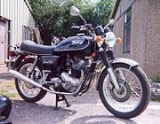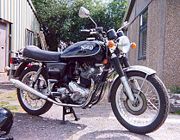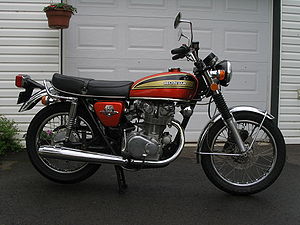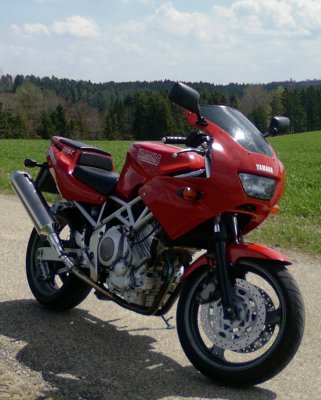
Straight-two
Encyclopedia
A straight-two engine, is a two-cylinder piston engine
that has its cylinders arranged side by side.
There are three crankshaft configurations for this engine: 360°, 180°, and the new 270°:
Unlike V-twin
s, straight-twin engines do not use a common crank pin for both connecting rod
s; each cylinder has its own crank pin. Most British straight-twin motorcycle engines from the 1930s through the 1980s, such as Triumph, BSA, Norton and Royal Enfield, had two main bearings. An exception was the AJS/Machless, which had a third, center main bearing.
Honda straight-twin engines, which began appearing in the late 1950s, had four main bearings. Subsequent straight-twin engines have four, or occasionally three, main bearings.
s like the Fiat 500
and Mitsubishi Minica
) and in farm equipment, notably by John Deere
whose large two-cylinder engines were used in their line of farm tractor
s up until 1960.
From 1967 to 1972, Honda produced the N360
and its successors N400 and N600 with straight-twin engines in 360 cc, 400 cc, and 600 cc sizes. The Z600 was produced from 1970 to 1972. From 1958 to 1971, Subaru produced the 360
with a rear-mounted, rear-drive 358 cc air-cooled engine.
Current production cars that use an inline twin engine include the Tata Nano
, which has a 623 cc engine; and the Fiat 500 TwinAir, which has a turbocharged
875 cc engine.
Ferrari
briefly considered creating an inline two-cylinder engine for Formula One
use in the 1950s. Aurelio Lampredi
worked with Enzo
and Dino Ferrari on this design
but abandoned the development after some tests of the engine in the F1-racer of that time. They hoped that the good low-end torque would make good for the lesser maximum power on twisting street-courses, but the fast escalating maximum power of the multi-cylinder-engines and the growing number of high-speed-courses killed the project.


 The motorcycle world generally knows these engines as "parallel twins" or "vertical twins", and the term "straight-two" is obsolete. "Parallel twin" refers to an engine mounted transversely across the frame; and the term "inline twin" refers to exclusively to an engine mounted inline with the frame, such as the Sunbeam S7. In four-stroke designs, the parallel twin is usually vertical or near vertical. An exception is the racing-only AJS Porcupine
The motorcycle world generally knows these engines as "parallel twins" or "vertical twins", and the term "straight-two" is obsolete. "Parallel twin" refers to an engine mounted transversely across the frame; and the term "inline twin" refers to exclusively to an engine mounted inline with the frame, such as the Sunbeam S7. In four-stroke designs, the parallel twin is usually vertical or near vertical. An exception is the racing-only AJS Porcupine
, which featured nearly horizontal cylinders, and Suzuki two-stroke, small bore, street-bikes.
Edward Turner
's 1937 Triumph Speed Twin
started a trend, and up to the mid-1970s four-stroke parallel twins were the most common type of British motorcycles, being produced by Triumph, BSA, Norton, Ariel, Matchless and AJS. Italian, German and USA manufacturers have also made parallel twins, but BMW have made the flat-twin
their trademark, while Moto-Guzzi, Ducati and Harley-Davidson have specialised in V-twins. Japanese manufacturers still make parallel twins, particularly for middleweight bikes. USA-made parallel twins include the 1949 440 cc Indian Scout and the 1950 500 cc Indian Warrior.
Although the rise in popularity of the large V-twin motorcycle has seen the parallel twin fall out of favour, the latter retains these advantages over the former:
; but in the 1960s, Japanese manufacturers favoured the 180° whose smoothness allowed higher rpm and thus more power. For example, the 1966 Honda 450 cc dohc 180° “Black Bomber" could outperform contemporary British 650 cc 360° twins.
Many small motorcycles of less than 250 cc use a 360° crankshaft as the vibration issue was less significant; examples includes Honda's CB92, CB160, CA72, CA77s, and CM185. Larger twins over 500 cc, such as the Yamaha's XS650 and TX750, have used 360° crankshafts, but such parallel twins tend to feature balance shafts. The Honda CB-series in the 250 to 500 cc range used 180° crankshafts. Both the 1973 Yamaha TX500 and the 1977 Suzuki GS400 featured a 180° crankshaft and a balance shaft, while the 1974 Kawasaki KZ400 used a 360° crankshaft and a balance shaft.
A 180° crankshaft engine suffers fewer pumping losses than a 360° twin, as displacement in the crankcase stays roughly constant. However, a 180° engine requires a separate ignition system, points or otherwise, for each cylinder. The 360° twins can have a single ignition system for both cylinders, with a wasted spark
on each cylinder's exhaust stroke. The BMW F800
parallel twin motorcycle is a 360° design. Inherent vibration in the BMW F800 means its engine is limited to 9,000 rpm. BMW reduced the vibration using a third "vestigial" connecting rod to act as a counterbalance.
In two-stroke engines, the crank angle is generally 180° with a working cycle every 180°. Such an engine will produce fewer vibrations. An exception is the Yankee
, which featured a 360° crankshaft. The Yankee's configuration, which featured separate combustion chambers for the two cylinders, should not be confused with that of a split-single
.
and the 2009 Triumph Thunderbird. A 270° engine requires a balance shaft to reduce vibration. Effectively, the 270° crank is a compromise that allows a more regular firing pattern than a 180° crank, and less vibration than a 360° crank. Also, just like a 90° V-twin (but unlike the 180° and 360°), the 270° crank never has both pistons stationary, thus aiding crankshaft momentum. The 270° crank firing intervals are not perfectly even, and this supposedly improves power delivery to the rear tyre, giving two fairly close power pulses followed by a "recovery gap".
Reciprocating engine
A reciprocating engine, also often known as a piston engine, is a heat engine that uses one or more reciprocating pistons to convert pressure into a rotating motion. This article describes the common features of all types...
that has its cylinders arranged side by side.
There are three crankshaft configurations for this engine: 360°, 180°, and the new 270°:
- In a 360° engine, both pistons rise and fall together. The dynamic balance is identical to that of a single-cylinder engine, but with twice the number of ignition pulses.
- In a 180° engine, one piston rises as the other falls. This gives good primary balance, albeit with a rocking couple; but results in irregular ignition pulses.
- In a 270° engine, one piston follows a quarter of a turn behind the other. This is a compromise between the first two types, yielding results similar to a V-twin.
Unlike V-twin
V-twin
A V-twin engine is a two-cylinder internal combustion engine where the cylinders are arranged in a V configuration.- Crankshaft configuration :Most V-twin engines have a single crankpin, which is shared by both connecting rods...
s, straight-twin engines do not use a common crank pin for both connecting rod
Connecting rod
In a reciprocating piston engine, the connecting rod or conrod connects the piston to the crank or crankshaft. Together with the crank, they form a simple mechanism that converts linear motion into rotating motion....
s; each cylinder has its own crank pin. Most British straight-twin motorcycle engines from the 1930s through the 1980s, such as Triumph, BSA, Norton and Royal Enfield, had two main bearings. An exception was the AJS/Machless, which had a third, center main bearing.
Honda straight-twin engines, which began appearing in the late 1950s, had four main bearings. Subsequent straight-twin engines have four, or occasionally three, main bearings.
Automobile use
In the past, straight-twin engines have been used in very small cars (e.g. Microcars, "light" cars, and city carCity car
A city car is a small car intended for use primarily in an urban area.City cars are sold worldwide and most automotive industry manufacturers have one or two in their line-up. In North-America city cars are often referred to simply as "subcompacts" alongside the superminis. These kind of cars...
s like the Fiat 500
Fiat 500
The Fiat 500 is a car produced by the Fiat company of Italy between 1957 and 1975, with limited production of the Fiat 500 K estate continuing until 1977. The car was designed by Dante Giacosa....
and Mitsubishi Minica
Mitsubishi Minica
-Minica Sedan:The first Minica was first introduced in October 1962 as a two-door sedan based on the Mitsubishi 360 light truck, sharing its front-mounted ME21 359 cc twin-cylinder air-cooled engine driving the rear wheels, transverse leaf springs in front and beam axle/leaf springs at the...
) and in farm equipment, notably by John Deere
Deere & Company
Deere & Company, usually known by its brand name John Deere , is an American corporation based in Moline, Illinois, and the leading manufacturer of agricultural machinery in the world. In 2010, it was listed as 107th in the Fortune 500 ranking...
whose large two-cylinder engines were used in their line of farm tractor
Tractor
A tractor is a vehicle specifically designed to deliver a high tractive effort at slow speeds, for the purposes of hauling a trailer or machinery used in agriculture or construction...
s up until 1960.
From 1967 to 1972, Honda produced the N360
Honda N360
The Honda N360 is a kei car, designed and built by Honda and produced from March 1967 through 1970, while its larger N600 brother lasted three more years. After a January 1970 facelift, the N360 became the NIII360 and continued in production until 1972...
and its successors N400 and N600 with straight-twin engines in 360 cc, 400 cc, and 600 cc sizes. The Z600 was produced from 1970 to 1972. From 1958 to 1971, Subaru produced the 360
Subaru 360
The Subaru 360 was the first automobile mass-produced by Fuji Heavy Industries' Subaru division. A number of innovative features were used to design a very small and inexpensive car to address government plans to produce a small "people's car" with an engine no larger than 360 cc when most in...
with a rear-mounted, rear-drive 358 cc air-cooled engine.
Current production cars that use an inline twin engine include the Tata Nano
Tata Nano
The Tata Nano is an inexpensive, rear-engined, four-passenger city car built by the Indian company Tata Motors and is aimed primarily at the Indian domestic market....
, which has a 623 cc engine; and the Fiat 500 TwinAir, which has a turbocharged
Turbocharger
A turbocharger, or turbo , from the Greek "τύρβη" is a centrifugal compressor powered by a turbine that is driven by an engine's exhaust gases. Its benefit lies with the compressor increasing the mass of air entering the engine , thereby resulting in greater performance...
875 cc engine.
Ferrari
Ferrari
Ferrari S.p.A. is an Italian sports car manufacturer based in Maranello, Italy. Founded by Enzo Ferrari in 1929, as Scuderia Ferrari, the company sponsored drivers and manufactured race cars before moving into production of street-legal vehicles as Ferrari S.p.A. in 1947...
briefly considered creating an inline two-cylinder engine for Formula One
Formula One
Formula One, also known as Formula 1 or F1 and referred to officially as the FIA Formula One World Championship, is the highest class of single seater auto racing sanctioned by the Fédération Internationale de l'Automobile . The "formula" designation in the name refers to a set of rules with which...
use in the 1950s. Aurelio Lampredi
Aurelio Lampredi
Aurelio Lampredi was an Italian automobile and aircraft engine designer.Born in Livorno, he began his career at Piaggio, makers of the Vespa scooter, but quickly moved up to larger engines...
worked with Enzo
Enzo Ferrari
Enzo Anselmo Ferrari Cavaliere di Gran Croce OMRI was an Italian race car driver and entrepreneur, the founder of the Scuderia Ferrari Grand Prix motor racing team, and subsequently of the Ferrari car manufacturer...
and Dino Ferrari on this design
Ferrari Lampredi engine
Aurelio Lampredi designed a number of racing engines for Ferrari. He was brought on to hedge the company's bets with a different engine family than the small V12s designed by Gioacchino Colombo. Lampredi went on to design a number of different straight-4, straight-6, and V12 engines through the...
but abandoned the development after some tests of the engine in the F1-racer of that time. They hoped that the good low-end torque would make good for the lesser maximum power on twisting street-courses, but the fast escalating maximum power of the multi-cylinder-engines and the growing number of high-speed-courses killed the project.
Motorcycle use



AJS Porcupine
-Racing history:The motorcycle was originally designed by AJS to be supercharged, as were a number of pre-war racing bikes, but the FICM banned supercharging in 1946. The motor was then worked on to allow it to perform without a supercharger...
, which featured nearly horizontal cylinders, and Suzuki two-stroke, small bore, street-bikes.
Edward Turner
Edward Turner
Edward Turner was a British motorcycle designer. He was born in Camberwell in the London Borough of Southwark, on the day King Edward VII was proclaimed King....
's 1937 Triumph Speed Twin
Triumph Speed Twin
The Speed Twin 5T is a motorcycle that was made by Triumph at their Coventry factory. Edward Turner, Triumph’s Chief Designer and Managing Director, launched the Triumph Speed Twin at the 1937 National Motorcycle Show. It was a 500 cc OHV vertical twin in a lightweight frame and the first...
started a trend, and up to the mid-1970s four-stroke parallel twins were the most common type of British motorcycles, being produced by Triumph, BSA, Norton, Ariel, Matchless and AJS. Italian, German and USA manufacturers have also made parallel twins, but BMW have made the flat-twin
Flat-twin
A flat-twin is a two cylinder internal combustion engine with the cylinders arranged on opposite sides of the crankshaft. It is part of the class of flat engines, sub-type "boxer", and shares most characteristics of those engines.-Motorcycle use:...
their trademark, while Moto-Guzzi, Ducati and Harley-Davidson have specialised in V-twins. Japanese manufacturers still make parallel twins, particularly for middleweight bikes. USA-made parallel twins include the 1949 440 cc Indian Scout and the 1950 500 cc Indian Warrior.
Although the rise in popularity of the large V-twin motorcycle has seen the parallel twin fall out of favour, the latter retains these advantages over the former:
- A parallel twin is cheaper to make, having only one cylinder block and one cylinder head.
- Both cylinders can have the exhaust pipe exiting at the front, in the cool air stream.
- Siting of ancillaries (air-filter, carburetters, ignition etc.) is simpler.
- This simpler layout can potentially make maintenance access easier.
- The parallel twin is both lighter and shorter, allowing a lighter frame and shorter wheelbase.
- The motorcycle's centre of gravity can be sited optimally, i.e. lower and further forward.
- Provided a 270° crank is used, a parallel twin can simulate the "feel" of a V-twin.
Crank angle (360° and 180°)
All classic British four-stroke parallel twin motorcycles used a crank angle of 360°, which allowed the use of a single carburetor. (180° and 270° twins need twin carburetors). An early Kawasaki was a clone of the 360° British BSA Golden FlashBSA Golden Flash
The BSA Golden Flash was a Birmingham Small Arms Company motorcycle. The Golden Flash was also available in black and chrome, but it was the all-over gold paint scheme that gave it the name, and made it such a popular escape from post war austerity....
; but in the 1960s, Japanese manufacturers favoured the 180° whose smoothness allowed higher rpm and thus more power. For example, the 1966 Honda 450 cc dohc 180° “Black Bomber" could outperform contemporary British 650 cc 360° twins.
Many small motorcycles of less than 250 cc use a 360° crankshaft as the vibration issue was less significant; examples includes Honda's CB92, CB160, CA72, CA77s, and CM185. Larger twins over 500 cc, such as the Yamaha's XS650 and TX750, have used 360° crankshafts, but such parallel twins tend to feature balance shafts. The Honda CB-series in the 250 to 500 cc range used 180° crankshafts. Both the 1973 Yamaha TX500 and the 1977 Suzuki GS400 featured a 180° crankshaft and a balance shaft, while the 1974 Kawasaki KZ400 used a 360° crankshaft and a balance shaft.
A 180° crankshaft engine suffers fewer pumping losses than a 360° twin, as displacement in the crankcase stays roughly constant. However, a 180° engine requires a separate ignition system, points or otherwise, for each cylinder. The 360° twins can have a single ignition system for both cylinders, with a wasted spark
Wasted spark
The wasted spark system is an ignition system used with some four-stroke cycle internal combustion engines. In a wasted spark system, the spark plugs fire in pairs even though one is on its compression stroke and one is on its exhaust stroke. The extra spark on the exhaust stroke has no effect and...
on each cylinder's exhaust stroke. The BMW F800
BMW GS parallel-twin
The BMW F800GS and F650GS are members of the GS family of dual-sport motorcycles manufactured in Berlin, Germany by BMW Motorrad. Both bikes were launched in 2008, and use the same 798 cc parallel-twin engine with chain drive, but with different power outputs and equipment levels...
parallel twin motorcycle is a 360° design. Inherent vibration in the BMW F800 means its engine is limited to 9,000 rpm. BMW reduced the vibration using a third "vestigial" connecting rod to act as a counterbalance.
In two-stroke engines, the crank angle is generally 180° with a working cycle every 180°. Such an engine will produce fewer vibrations. An exception is the Yankee
Yankee (motorcycle)
The Yankee motorcycle is a motorcycle which was produced in Schenectady, New York by the Yankee Motor Company in the 1970s. This company was started by John Taylor, a long-time resident of that area....
, which featured a 360° crankshaft. The Yankee's configuration, which featured separate combustion chambers for the two cylinders, should not be confused with that of a split-single
Split-single
The split-single , is a variant on the two-stroke engine with two cylinders sharing a single combustion chamber.There have been "single" and "twin" The split-single (Doppelkolbenmotor to its German and Austrian manufacturers), is a variant on the two-stroke engine with two cylinders sharing a...
.
Crank angle (270°)
A modern development is the 270° crank, which imitates the sound and feel of a 90° V-twin. The concept was pioneered by the Yamaha TRX850 and used lately in the Yamaha XT1200Z Super TénéréYamaha XT1200Z Super Ténéré
The Yamaha XT1200Z Super Ténéré is a motorcycle produced by Yamaha Motor Corporation, that was launched in 2010.The XT1200Z is the latest in a series of dual-sport Yamaha motorcycles named after the Ténéré, a desert region in the south central Sahara...
and the 2009 Triumph Thunderbird. A 270° engine requires a balance shaft to reduce vibration. Effectively, the 270° crank is a compromise that allows a more regular firing pattern than a 180° crank, and less vibration than a 360° crank. Also, just like a 90° V-twin (but unlike the 180° and 360°), the 270° crank never has both pistons stationary, thus aiding crankshaft momentum. The 270° crank firing intervals are not perfectly even, and this supposedly improves power delivery to the rear tyre, giving two fairly close power pulses followed by a "recovery gap".
External links
- A detailed analysis of the effect of different crankshaft offset angles on the engine balanceEngine balanceEngine balance is the design, construction and tuning of an engine to run smoothly. Improving engine balance reduces vibration and other stresses and can improve the overall performance, efficiency, cost of ownership and reliability of the engine, as well as reducing the stress on other machinery...
of a straight twin engine.

